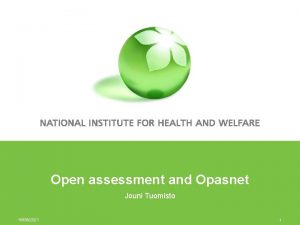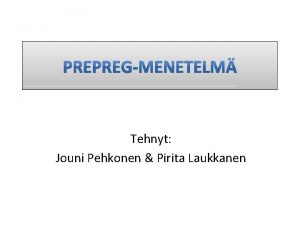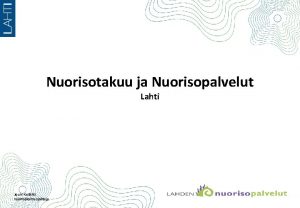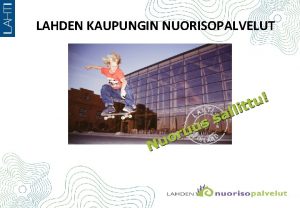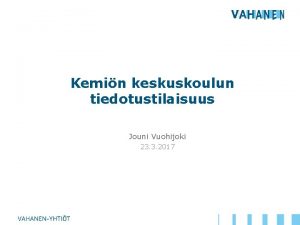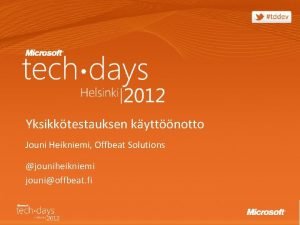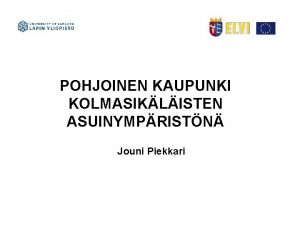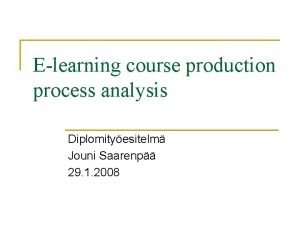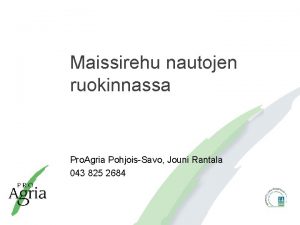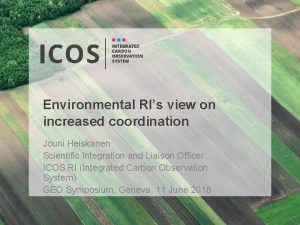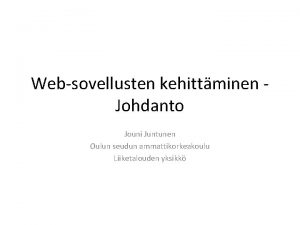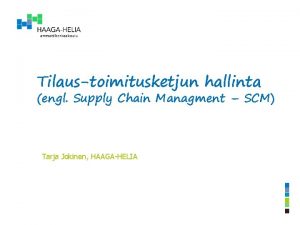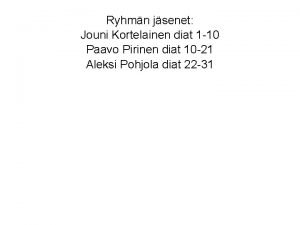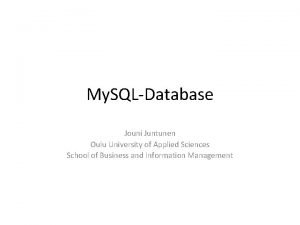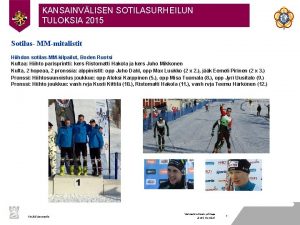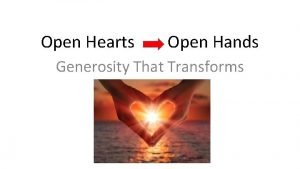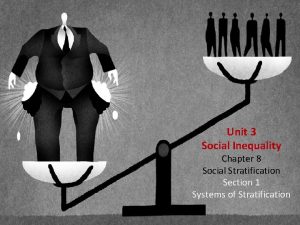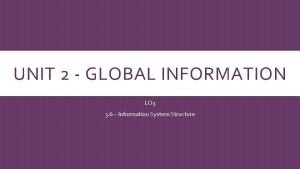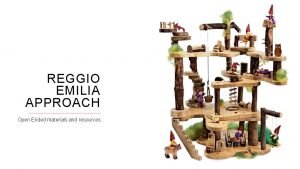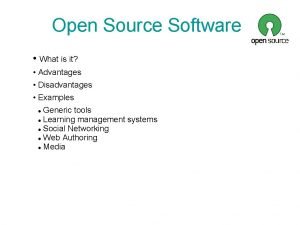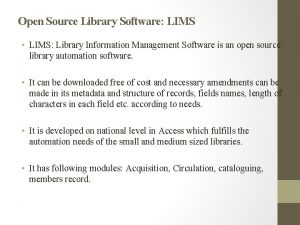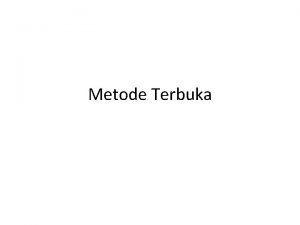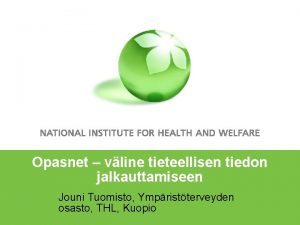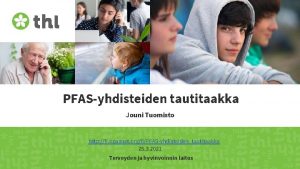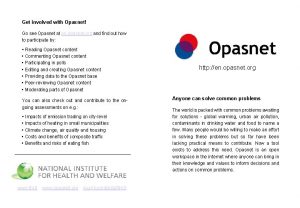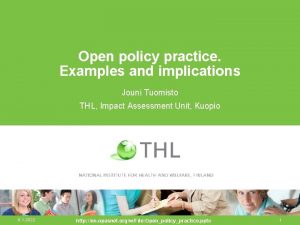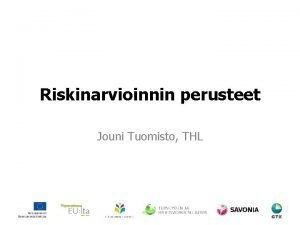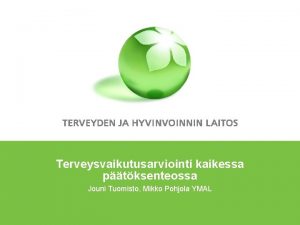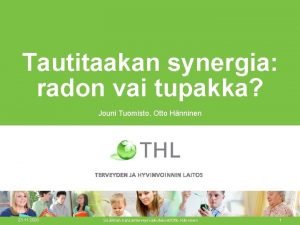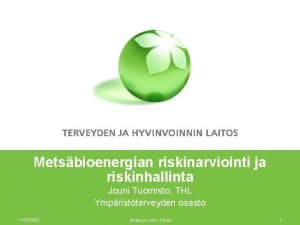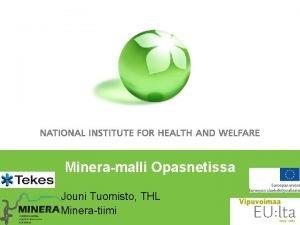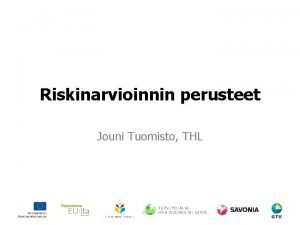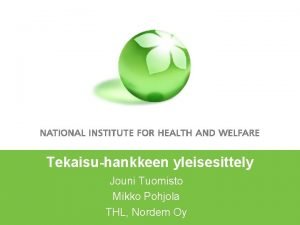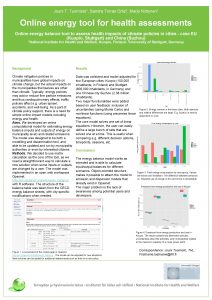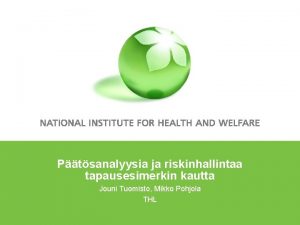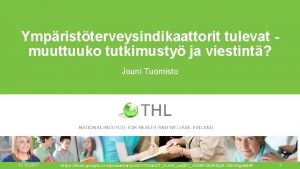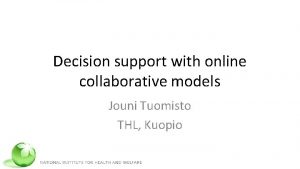Open assessment and Opasnet Jouni Tuomisto 16062021 1









































- Slides: 41

Open assessment and Opasnet Jouni Tuomisto 16/06/2021 1

Outline / Menu • • • Motivation Examples Assessment structure Technical functionalities Challenges Way forward 16/06/2021 Marjo Niittynen, Jouni T. Tuomisto 2

An impact assessment in Opasnet 16/06/2021 Marjo Niittynen, Jouni T. Tuomisto 3

Climate change policy model 16/06/2021 Marjo Niittynen, Jouni T. Tuomisto 4

Links to the pages of climate change policy model • http: //en. opasnet. org/w/Climate_change_policies_an d_health_in_Kuopio • http: //en. opasnet. org/w/Building_model • http: //en. opasnet. org/w/Building_stock_in_Kuopio • http: //en. opasnet. org/w/Emission_factors_for_burnin g_processes • http: //en. opasnet. org/w/Exposure_to_PM 2. 5_in_Finl and • http: //en. opasnet. org/w/Population_of_Kuopio 16/06/2021 Marjo Niittynen, Jouni T. Tuomisto 5

Motivation • Open assessment aims to develop impact assessment practices and improve the information flow between experts and decision makers. • Research question: How can scientific information and value judgements be organised to support decision making in such a way that open participation is allowed? 16/06/2021 Marjo Niittynen, Jouni T. Tuomisto 6

Basic structure of a page 16/06/2021 Marjo Niittynen, Jouni T. Tuomisto 7

Six principles are applied: – Intentionality: All that is done aims to offer better understanding to the decision maker about outcomes of the decision. – Shared information objects: all information is shared using a systematic structure and a common workspace where all participants can work. – Causality: The focus is on understanding the causal relations between the decision options and the intended outcomes. – Critique: All information presented can be criticised based on relevance and accordance to observations. – Reuse: All information is produced in a format that can easily be used for other purposes by other people. – Openness: All work and all information is openly available to anyone interested. Participation is free. If there are exceptions, these must be publicly justified. 16/06/2021 Marjo Niittynen, Jouni T. Tuomisto 8

Opasnet web-workspace • Motto: You must be able to do any work in Opasnet, whether you are a researcher or a decision-maker. • It is designed for effective information management and use. • Parts: – – 16/06/2021 Opasnet wiki: the user interface R statistical software for online models Mongo. DB database for all kinds of data File management system. Marjo Niittynen, Jouni T. Tuomisto 9

Challenges • Surprisingly: lack of interest in participating. • Openness seen as threat or potential cause of trouble. • Researchers are not familiar with R. • Decision makers have no time nor resources to do anything extra. 16/06/2021 Marjo Niittynen, Jouni T. Tuomisto 10

Why Opasnet and ovariables? • The six principles are strict, and most existing data sharing or assessment practices violate several of them. • The ovariable structure and the databases in Opasnet arguably offer a method to fulfil all principles at the same time. • Because they are very generic, they could be used as data management, storage, and archive standards. But only if – people know them well enough to routinely use them, – coworkers use them as well. 16/06/2021 Marjo Niittynen, Jouni T. Tuomisto 11

Threshold of new practices • Changing working practices is always difficult, because you know your current practices. • In the case of ovariables, most benefits only come when many other people use them as well. – To a primary researcher the benefits are not obvious, because they mostly come in impact assessment. 16/06/2021 Marjo Niittynen, Jouni T. Tuomisto 12

Take-home messages • Open assessment is a method in production. • Opasnet can be used by anyone. • A critical mass of experts / modellers is still missing. – When we get that, the system becomes increasingly more effective and attractive. • NOW is the time to join Open Assessors’ Network. 16/06/2021 Marjo Niittynen, Jouni T. Tuomisto 13

Basic idea of ovariables: example • How to handle complex information in a model in a standardised and efficient way? • Three grams of SO 2 deposits onto the ground per m 2. What is the total deposition on the area of 2 m 2? • 3 g /m 2 * 20 m 2 = 60 g • Simple to do with any software. 16/06/2021 Marjo Niittynen, Jouni T. Tuomisto 14

More complex example • The deposition is four and three grams per m 2 of SO 2 in 2011 and 2012, respectively. What is the total deposition on the areas of 20 and 100 m 2? • On a spreadsheet, you could put years as rows and areas as columns. However, if you have to add a third dimension, your approach falls apart. • Instead, you could do it a bit more cleverly: 16/06/2021 Marjo Niittynen, Jouni T. Tuomisto 15

How to use 2 D tables for multidimensional data Area Year Deposition rate Total deposition 20 2011 4 80 20 2012 3 60 100 2011 4 400 100 2012 3 300 16/06/2021 Marjo Niittynen, Jouni T. Tuomisto 16

The idea of information objects • Object area (units m 2) Place Result Patio 20 Garden 100 • Object deposition. rate (units g /m 2) Year Result 2011 4 2012 3 – Explanation column (index) Observation column (result) • The usability is different than that of a spreadsheet. 16/06/2021 Marjo Niittynen, Jouni T. Tuomisto 17

Calculations with ovariables • total. deposition <- deposition. rate * area Place Year deposition. ra area. Result te. Result total. depositi on. Result Patio 2011 4 20 80 Patio 2012 3 20 60 Garden 2011 4 100 400 Garden 2012 3 100 300 • Indices are used to combine matching rows • Intermediate results are shown as well. 16/06/2021 Marjo Niittynen, Jouni T. Tuomisto 18

How many rows in the output with these indices? Place Year SO 2 policy Pollutant Patio 2011 BAU SO 2 Garden 2012 Active NOx 2013 2014 • 32 rows – at most. 16/06/2021 Marjo Niittynen, Jouni T. Tuomisto 19

How ovariables are merged Year SO 2 policy Pollutant policy. Result 2011 BAU SO 2 1 2011 Active SO 2 0. 9 2013 BAU SO 2 1 2013 Active SO 2 0. 7 Year Pollutant deposition. r ate. Result 2011 SO 2 4 2012 SO 2 3 2013 SO 2 2. 8 2011 NOx 1 2012 NOx 0. 9 2013 NOx 0. 9 16/06/2021 Place area. Result Patio 20 Garden 100 • In this case, only 8 rows merge successfully. Marjo Niittynen, Jouni T. Tuomisto 20

Data storage in Opasnet • Opasnet. Base has several interfaces – Table 2 Base <t 2 b> – Opasnet. Base. Import (Upload data and Show results) – opbase. upload() and opbase. data() • Opasnet server for R objects – objects. put() and objects. get() – objects. store() and objects. latest() • Opasnet wiki for files – Upload file and opasnet. data, opasnet. csv • M-files for permanent documents, eg. Reports 16/06/2021 Marjo Niittynen, Jouni T. Tuomisto 21

Opasnet. Base • Versatile database for 2 D tables. • Data can be uploaded from – User interface Opasnet. Base. Import – Wiki page using <t 2 b> – From R using opbase functions 16/06/2021 Marjo Niittynen, Jouni T. Tuomisto 22

Opasnet server • Stores model runs and R objects created in models. • Is used to store intermediate objects in models. 16/06/2021 Marjo Niittynen, Jouni T. Tuomisto 23

Opasnet wiki for files • Upload file functionality in wiki • Files can be accessed from R using functions opasnet. data and opasnet. csv 16/06/2021 Marjo Niittynen, Jouni T. Tuomisto 24

Building stock, climate policies and health in cities Jouni Tuomisto, Marjo Niittynen, THL Marjo Niittynen, Jouni T. Tuomisto 16/06/2021 25

Background • Buildings are in a key role when reducing greenhouse gas (GHG) emissions. – They consume energy in heating and cooling. – Different heating solutions differ in emissions and health impacts. • Buildings affect health in several ways. – Ventilation, heat/cold, dampness, biomass burning, radon, smoking, space, neighbourhood etc… • How to reduce GHG emissions and promote health at the same time? 16/06/2021 Marjo Niittynen, Jouni T. Tuomisto 26

Buildings in Basel by floor area 16/06/2021 Marjo Niittynen, Jouni T. Tuomisto 27

Buildings by age on map 16/06/2021 Marjo Niittynen, Jouni T. Tuomisto 28

Building stock model 16/06/2021 Marjo Niittynen, Jouni T. Tuomisto 29

Building floor area in Basel 16/06/2021 Marjo Niittynen, Jouni T. Tuomisto 30

Building energy need in Basel 16/06/2021 Marjo Niittynen, Jouni T. Tuomisto 31

Emissions in Basel 16/06/2021 Marjo Niittynen, Jouni T. Tuomisto 32

CHP plant in Haapaniemi 16/06/2021 Marjo Niittynen, Jouni T. Tuomisto 34

The study • Building stock model to predict past and future energy need of Kuopio. • Includes two policies: – Fuel policy • BAU: in Haapaniemi CHP plant, 85 % of peat is used. • Biofuel increase: 25 % peat, 60% wood. – Renovation policy • BAU: 3 % of buildings is energy-renovated per year • Active renovation: 4. 5 % per year • Effective renovation: more amibitious renovations 16/06/2021 Marjo Niittynen, Jouni T. Tuomisto 35

Causal chain • • • 16/06/2021 Building stock (floor area) Heating energy need Heating systems PM 2. 5 and CO 2 emissions Dispersion of and exposure to PM 2. 5 Health impacts of PM 2. 5 Marjo Niittynen, Jouni T. Tuomisto 36

Building stock 16/06/2021 Marjo Niittynen, Jouni T. Tuomisto 37

Heating energy 16/06/2021 Marjo Niittynen, Jouni T. Tuomisto 38

Emissions 16/06/2021 Marjo Niittynen, Jouni T. Tuomisto 39

Health impacts 16/06/2021 Marjo Niittynen, Jouni T. Tuomisto 40

Conclusions from the case studies • Health impacts of district heating are small in all Kuopio scenarios (in the order of 10 DALY / year) • However, the impact of primary wood heating in houses is relatively large (7 DALY / year) • Assumption of zero-carbon-emission from wood should be revisited using the LCA. 16/06/2021 Marjo Niittynen, Jouni T. Tuomisto 49

Conclusions from the building model • An online building stock model was developed and connected to energy use and health impact models. – The model is robust, i. e. it works with data with different level of coarseness. – It will be combined with the energy balance model before the end of project. • Availability (or sharability) of data is a major issue – Model should be usable by cities themselves. • More discussion is needed between policy makers and researchers/experts. – Development of practical scenarios. – Providing scientific info in readily-usable format. 16/06/2021 Marjo Niittynen, Jouni T. Tuomisto 50
 Jouni tuomisto
Jouni tuomisto Jouni tuomisto
Jouni tuomisto 16062021
16062021 Open innovation open science open to the world
Open innovation open science open to the world Jouni pehkonen
Jouni pehkonen Jouni kivilahti
Jouni kivilahti Lahden kaupunki organisaatio
Lahden kaupunki organisaatio Jouni vuohijoki
Jouni vuohijoki Jouni honka-aho
Jouni honka-aho Yksikkötesti
Yksikkötesti Jouni piekkari
Jouni piekkari Jouni saarenpää
Jouni saarenpää Jouni rantala
Jouni rantala Eqs sem
Eqs sem Jouni heiskanen
Jouni heiskanen Jouni juntunen
Jouni juntunen Tilaus-toimitusketju
Tilaus-toimitusketju Jouni kortelainen
Jouni kortelainen Jouni juntunen
Jouni juntunen Hiihdon mm 2015
Hiihdon mm 2015 Normally open, timed-closed contact symbol
Normally open, timed-closed contact symbol Open hearts open hands
Open hearts open hands Open source assessment platform
Open source assessment platform Principle in portfolio assessment
Principle in portfolio assessment Define dynamic assessment
Define dynamic assessment Portfolio assessment matches assessment to teaching
Portfolio assessment matches assessment to teaching Strengths of reading
Strengths of reading Open and closed stratification systems
Open and closed stratification systems Open vs closed system
Open vs closed system Close ended materials
Close ended materials Clearinghouse probe
Clearinghouse probe Don would always open the mail throw away the junk mail and
Don would always open the mail throw away the junk mail and Open source software disadvantages
Open source software disadvantages Free open source library software
Free open source library software Honest and open communication in school
Honest and open communication in school Module 4 - open source software and licensing
Module 4 - open source software and licensing Metode terbuka
Metode terbuka In block
In block Short memorized speech examples
Short memorized speech examples Earth closed system
Earth closed system Closed and open figures
Closed and open figures Open and honest communication in a relationship
Open and honest communication in a relationship


